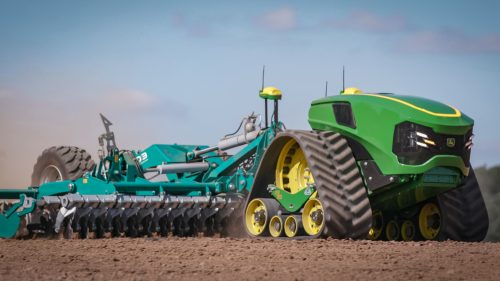Precision Agriculture Future Technology Zone
14 November 2019 Ben Burgess News Industry News

The future begins in the Future Technology Zone
In a new exhibition concept at this year’s Agritechnica, John Deere is demonstrating its leading position in precision agriculture in the Future Technology Zone. Nine different product developments and research projects in the fields of electrification, autonomy through automation and artificial intelligence show how agriculture could work even more sustainably and productively in the future.
Electrification
Zero emission compact utility tractor: This electric compact tractor is based on the John Deere 1 Series. A key feature of this machine is its high PTO power, allowing more than 10,000m² of lawn to be mowed with one battery charge lasting 4.5 hours. In addition to high performance, customers benefit from very low maintenance costs. Potential applications are mainly where low noise levels and emission-free operation are required.
eAutoPowr transmission: eAutoPowr is the first continuously variable transmission with an electro-mechanical power split. Compared to conventional CVTs, the drive is more efficient and wear-free. Another special feature is the provision of up to 100kW of electrical power for external consumption. To demonstrate this, John Deere and Joskin have developed a slurry tanker with two electric drive axles. Thanks to this eight-wheel drive system, much more efficient transmission of tractive power is possible. This can also reduce slurry incorporation costs by up to 25 per cent.
Autonomy through automation
Autonomous electric tractor: John Deere’s new autonomous tractor concept is a very compact electric drive unit with integrated attachment. The tractor has a total output of 500kW and can be equipped with either wheels or tracks. Flexible ballasting from 5 to 15 tonnes is possible, depending on the application, to help reduce soil compaction. Thanks to the electric drive, there are no operating emissions and noise levels are extremely low. Further advantages include low wear and maintenance costs.
Semi-autonomous tractor: This tractor drives semi-autonomously and is equipped with an integrated crop sprayer. Using a built-in camera, it is possible to work in row crops – for example, applying plant protection products to fruit tree plantations. Filling the sprayer tank takes place fully automatically at a filling station, so the user is not exposed to pesticides. This is designed to reduce costs and increase productivity by over 30 per cent.
Autonomous drone sprayer: This drone is equipped with a weed scanner and crop sprayer, allowing weeds to be scanned from the air and then specifically controlled. The 10.6-litre tank is filled fully automatically at a field boundary station, where the automatic battery charge also takes place. Flight time with a fully charged battery is 30 minutes. The main advantage of this drone is the precise application of pesticides, which significantly reduces the amounts used. Spraying from the air is also possible regardless of ground conditions.
Autonomous sprayer: This novel autonomous sprayer has a 560-litre spray tank. The high ground clearance of 1.9m and four-wheel steering make it extremely versatile, while the tracks minimise ground pressure and greatly extend the operating window.
Artificial intelligence
Blue River Technology: With See & Spray technology, high-resolution cameras capture 20 images per second. Based on the images and artificial intelligence, the system recognises the difference between cultivated plants and weeds so that individual plants can be specifically treated. With this new generation of weed control, the use of pesticides can be greatly reduced.
Command Cab: The future vision of a driver’s cab reveals new possibilities for artificial intelligence. With its joystick control, touchscreen display and networking of all machine components, John Deere presents a completely new operating concept. By integrating real-time weather data, individual pre-settings and job management procedures, the cab becomes the command centre for agricultural operations.
Large spraying drone (VoloDrone): The large drone developed jointly by John Deere and Volocopter has a diameter of 9.2m and is powered by 18 rotors. It has a fully electric drive with replaceable lithium-ion batteries. One battery charge allows a flight time of up to 30 minutes, and the VoloDrone can be operated both remotely and automatically, on a pre-programmed route. The drone frame is equipped with a flexible standardised payload attachment system. This means that different devices can be mounted on the frame, depending on the application. For crop protection, the large drone is equipped with two liquid tanks, a pump and a spray bar. Thanks to the low flying height, very large area coverage of up to 6ha/hr can be achieved.

